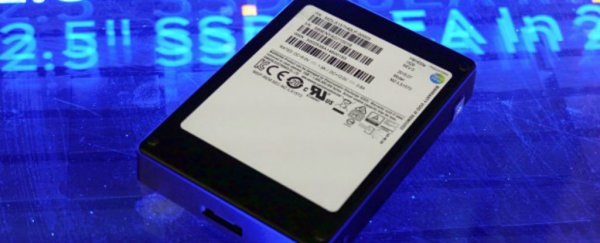You know what's not going away? Our need to store digital information. Whether it's photos, movies, video games, or entire seasons of Game of Thrones, our ever-increasing library of hefty digital files needs somewhere to live in perpetuity, and if that can't be the cloud, we'll have to rely on external hard drives.
The problem is, we're now fast-approaching the point where the largest solid state drives (SSD) on the market - made by Seagate and Western Digital at 8-10TB - will no longer be enough. So how does 15.36TB sound?
Last week, Samsung announced that it has started shipping "the industry's largest solid state drive", first announced back in August, which packs close to 16TB.
"To put things in perspective, 16 terabytes would hold over 3 million MP3s, more than 4,000 movies, nearly 5 million digital photos… you get the picture. This sucker is huge," Peter Dockrill reported for us last year. "It's 1,000 times bigger than an entry-level iPhone and 32 times bigger than the storage in the computer on which I'm writing these words."
With the very charismatic name of PM1633a, this thing is just 6 cm long (2.5 inches), which makes it entirely portable and pocket-sized, and features a pretty ingenious way to stuff all that capacity inside.
As Sebastian Anthony explains for Ars Technica, the SSD uses something called a 256Gbit (32GB) NAND flash die, which is twice the capacity of similar flash chips that are currently on the market.
"The NAND chips are constructed in layers, stacking up to 24 individual NAND cells on top of each other. This lets Samsung scale the chip's capacity up without having to add more NAND cells in a series," Anthony explained back in 2013. Samsung has now managed to stack 48 layers of NAND cells on top of each other.
If that doesn't make a whole lot of sense to you, think about it this way. Instead of layering everything on the chip horizontally on a two-dimentional plane, the NAND cells are turned on their side in a system that allows for nanometre-sized three-dimensional structures.
"The simplest way of describing 3D NAND is that everything is turned on its side: so instead of having just one layer of memory cells on a single plane, you can now have dozens of layers of cells, all standing up next to each other," says Anthony.
The 15.36TB SSD is packing up to 500 of these new NAND flash chips.
So that's the good news, here's the bad news: Samsung has not yet revealed the price of the PM1633a, but you'd probably be looking at several thousand dollars. But, as PC Mag reports, Samsung is also releasing 7.68TB, 3.84TB, 1.92TB, 960GB, and 480GB versions later this year, so we could still get a look-in.
Meanwhile, if speed is more your thing, Seagate has just announced that it's launching the fastest SSD in the world within months, claiming that this device can move data at up to 10GB per second.
While that one's probably not going to be any cheaper than Samsung's device, if history has taught us anything, it's that those prices are going to drop FAST. Maybe we won't have to delete all those identical cat photos to save space after all.
